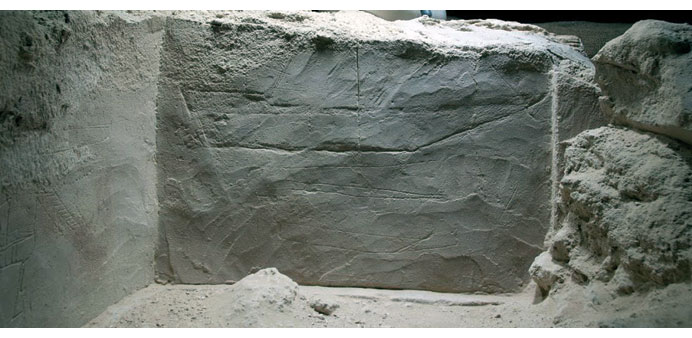Graffiti of boats found etched on the wall plaster of buildings at Al Zubarah Archaeological Site.
Recent analysis of graffiti found by archaeologists in 250-year-old buildings at Al Zubarah Archaeological Site reiterates that Qatar was a centre for international trade in the 18th century.
“The majority of the etchings are of boats, with European, Indian and locally made vessels among them,” Qatar Museums announced in a statement yesterday.
Working alongside Faisal al-Naimi, head of archaeology at Qatar Museums, and Tom Collie of the University of Copenhagen, specialists at the University of Exeter Dr John Cooper and Professor Dionisius Agius have spent a year studying the enigmatic depictions of boats found etched on the wall plaster of buildings at the site.
The team studied 15 different images and concluded that they represent boats from across the world, including a probable European war vessel, a locally made fishing vessel and trade dhows traditionally made on the Malabar Coast (northern Kerala) of India.
In a presentation at the British Museum in London, Dr Cooper demonstrated that the etchings were made on dry plaster, within finely plastered buildings at the site. Although some of the images are only rudimentary outlines of hulls, others show enough detail to identify their type. These tend to depict large ocean-going ships that were used for trade in the Arabian Gulf and Indian Ocean region.
The technical detail of the rigging, rudders and other aspects of the etchings show that the graffiti artists must have had an intimate knowledge of these vessels, emphasising their close relationship with the sea.
Some of the dhow etchings have already been removed from the site by specialist plaster conservators for consolidation and further treatment in the laboratory, while others have been re-buried to protect them from the elements. A plaster impression of one of the removed etchings can be seen in the temporary exhibition at Al Zubarah.
Al Zubarah Archaeological Site, which became Qatar’s first Unesco World Heritage Site in 2013, is open to the public every day from 9am to 4.30pm. A new exhibition on pearling and seafaring opened in Al Zubarah Fort in May this year.
A historic coastal town now abandoned, the Al Zubarah site lies on Qatar’s northwest coast 85km from Doha. Founded in the 18th century, the town developed into a centre of the pearling and international trade and rose to become the country’s largest and most important settlement.
The success of Al Zubarah attracted the attention of other Gulf powers, and after several attacks the town was eventually burned to the ground in 1811. It never fully recovered and was abandoned by the mid-20th century.
Al Zubarah Archaeological Site covers an area of 60 hectares with remains of houses, mosques, large fortified buildings and a market. More information could be had from www.alzubarah.qa



